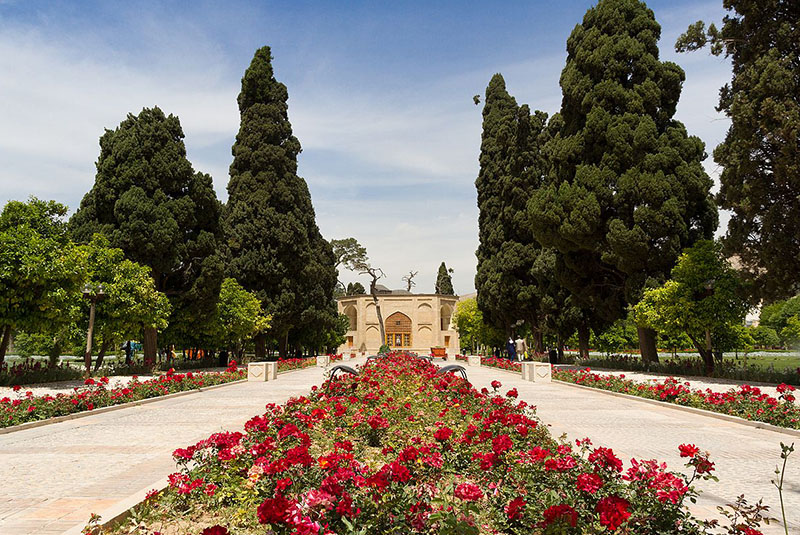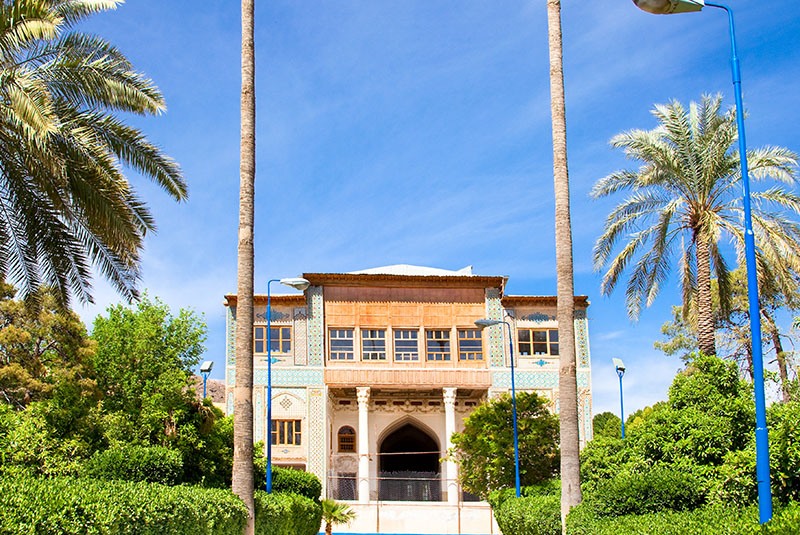The Most Beautiful Gardens in Shiraz
The city of Shiraz in one of the most amazing cities in Iran which has a number of beautiful gardens. If you travel to Shiraz in spring, you will be amazed by the magnificent fragrance of orange blossoms which spread all over the town. Here, we are going to introduce some of the most beautiful gardens in Shiraz.

Eram Garden
Eram Garden (in Farsi; Bagh-E Eram) is one of the nine Persian Gardens inscribed on UNESCO‘s World Heritage Sites. It is not still clear when the garden was exactly built, however, according to historical evidence it is said that the garden was built during the Seljuk period. But what is for sure is that the mansion in the middle of the garden was built in the 19th century. The walls and floor of the hall are covered with colorful tiles. The beautiful three-story pavilion of the garden was constructed based on Safavid and Qajar style of architecture.
The most interesting part of the garden is a passageway built from the east to the west in the middle of the garden, and on both sides, the cedar trees have been planted.
| Read more: Best Hotels in Shiraz You Never Want to Leave

Today, Eram Garden and building are within Shiraz Botanical Garden (established in 1983) of Shiraz University. Since the garden is surrounded by tall cypress trees, fragrant flowers, and aromatic sour orange trees it has a wonderful atmosphere, especially in spring.
One of the most famous trees in the garden is a beautiful 200-year-old towering cypress tree that globally known as Sarv-e- Naz. It attracts many visitors from around the world to the garden.
| Discover: Tomb of Hafez | Famous Persian Poet
Narenjestan Qavam Garden
Among all of the traditional and colorful houses in Shiraz, one which is most famous and attracts many visitors every day is Narenjestan Qavam House and Garden. When you enter the garden and pass the corridor you will face an unforgettable garden, and you will surely be amazed by the interior design of the house.
There are a number of orange trees, especially sour orange in the garden which is called “Narenj” in Farsi, and that is the reason why the house is known as Narenjestan which literally means “Place of Narenj” in Farsi.

Narenjestan Qavam Garden covers approximately 3,500 square meters and the building has an area of 940 square meters in two northern and southern wings. The beautifully designed garden is along with the southern mansion and the main mansion. There is a big pool in the garden in which the image of the main mansion reflects in it. The same as every Persian Garden in the country there are symmetric spaces on both sides of the garden.
| Suggestion: Top 15 Traditional Hotels in Shiraz to Stay in
Jahan Nama Garden
Jahan Nama Garden is located at the entrance of the city on Hafez Street and is being fed with Rokni River. The garden probably dates back to the Zandieh era and the present designs of it have been made in the 18th century. The same as other gardens in Shiraz it has a building in the middle of the garden with traditional interior design.
The garden used to be an important one during the Safavid Era, however, after the extinction of the Safavid Dynasty, it almost destroyed. Later, during the reign of Karim Khan Zand, the garden was renovated and they built a mansion in it. At the same time, they fenced the garden and organized the structure of the plantings around the mansion. In Qajar Era, the garden hosted guests of the government.

The same as every garden in Iran, Jahan Nama Garden has three main features such as locating along a ditch, surrounded by tall walls, and having a summer mansion with a swimming pool.
What makes Jahan Nama Garden, a unique garden in Shiraz is the repetition of number 8 in the garden. There are 8 cypresses on each of the main paths, 8 sections to the long rill, and 8 fountains to each section. There are also large areas of colorful planting in geometric flower beds.
| Discover: Best Restaurants in Shiraz You Shouldn't Miss!
Delgosha Garden
The beautiful and historical Delgosha Garden is located near the Tomb of Saadi. The construction of the garden and its mansion dates back to three eras of Sassanid, Safavid, and Qajar. The garden was registered in Iran’s National Heritage in 2002 under the registration number of 912.
In the Timurid Dynasty when Timur was the king, this garden was magnificently in its best situation. As Timur was impressed by the garden, he ordered to build a garden with the same name in Samarqand.
The same as all Persian Gardens it is located near a water current, it is walled with tall walls and finally, it has a mansion and a pool inside. Delgosha Garden area is about 57000 meters square. The main entrance is on the south side of the garden.

It is said that the first pavilion in Iran was recorded in Delgosha Garden. The three-story mansion in the middle of the garden has two entrances. A balcony in the center of the mansion with two columns has a fantastic view of a very lovely pool. The balcony is decorated with Nastaliq handwriting and attracts the attention of every visitors.
Today, much of the garden has been insensitively modernized with concrete paving and blue painted water channels.
| Suggestion: Iranian Traditional Houses
Afif Abad or Golshan Garden
Afif-Abad Garden or Golshan Garden is a museum complex in Shiraz. It was built by Mirza Ali Mohammad Khan Ghavam al-Mulk.
The two-story building in the middle of the garden is decorated with great tilling. There are stone columns with the same style of columns in the Persepolis. There are approximately 30 chamber halls, and two carved marble fireplaces in the north and south of the hall. The buildings and decorations of the garden are a mixture of Achaemenid, Sassanid, Zand, and Qajar architectures and styles.

Afif Abad or Golshan Garden covers an area of 127,000 square meters. It was a very important garden during the Safavid era and was the recreation place of the king. The Afif Abad was called Baq-e Golshan (the Golshan garden) at that time. There is an edifice in the garden with pools and a basement floor.
It is noteworthy to mention that during the second Pahlavi era, the descendants of Qavam family presented the garden as a gift to Queen Farah, and finally, in 1962, it was bought by the Iranian Army at an auction. In 1972, the whole complex was registered as a national property with Number 913 in Iran’s cultural heritage organization. Later, in 1991, the garden became the military museum which consists of two major parts, the gun museum, and the Ebrat Museum.
Nazar Garden
Nazar Garden was the first constructed garden during the Zand Dynasty which is situated in the southern side of Toopkhaneh square.
There are a number of cedar, pine, and sour orange trees in the garden. As it was the administrative garden during the Zand Dynasty, it was dedicated to host foreign guests and holding salute ceremonies.
The octagonal pavilion at the center of the garden was built by the order of Karim Khan Zand who was buried in the same place. However, later on, Aqa Mohammad Khan, the founder of the Qajar dynasty (1785 to 1925), ruthlessly took Karim Khan’s bones to his palace in Tehran (Golestan Palace) and buried them under the stairs he used to pass over every day.

In 1936, the pavilion of Bagh-e Nazar converted to a museum (Pars museum) which is decorated with intricate tile work on the outer walls and spandrels, bearing bird and flower motifs, hunting and feast scenes.
Pars museum is a treasury of valuable relics such as potteries, paintings, manuscripts, a collection of Quran manuscripts, and lacquered works from pre-Islamic and Islamic eras.
The most visited part of the museum is the tomb of Karim Khan Zand in the eastern room.


Comment
Leave a Comment